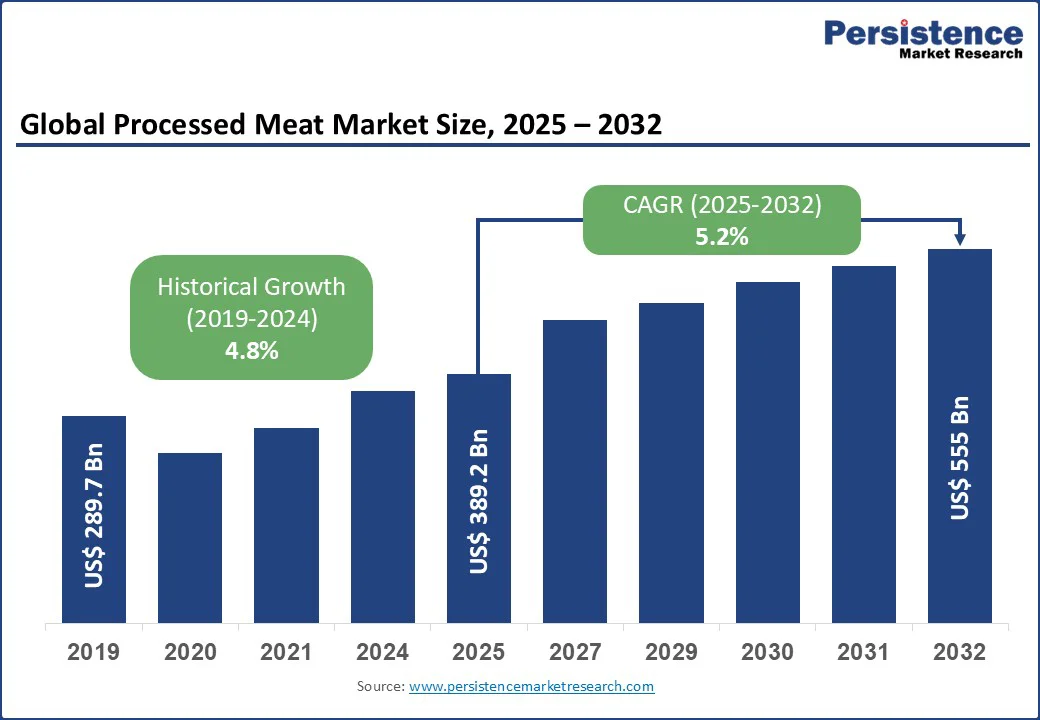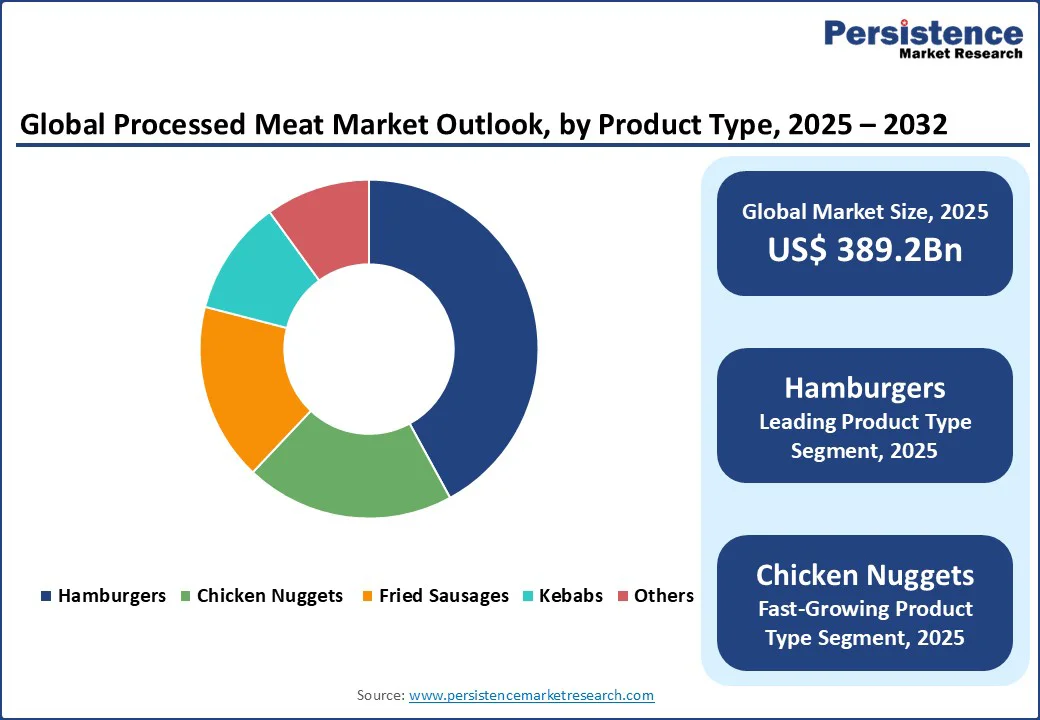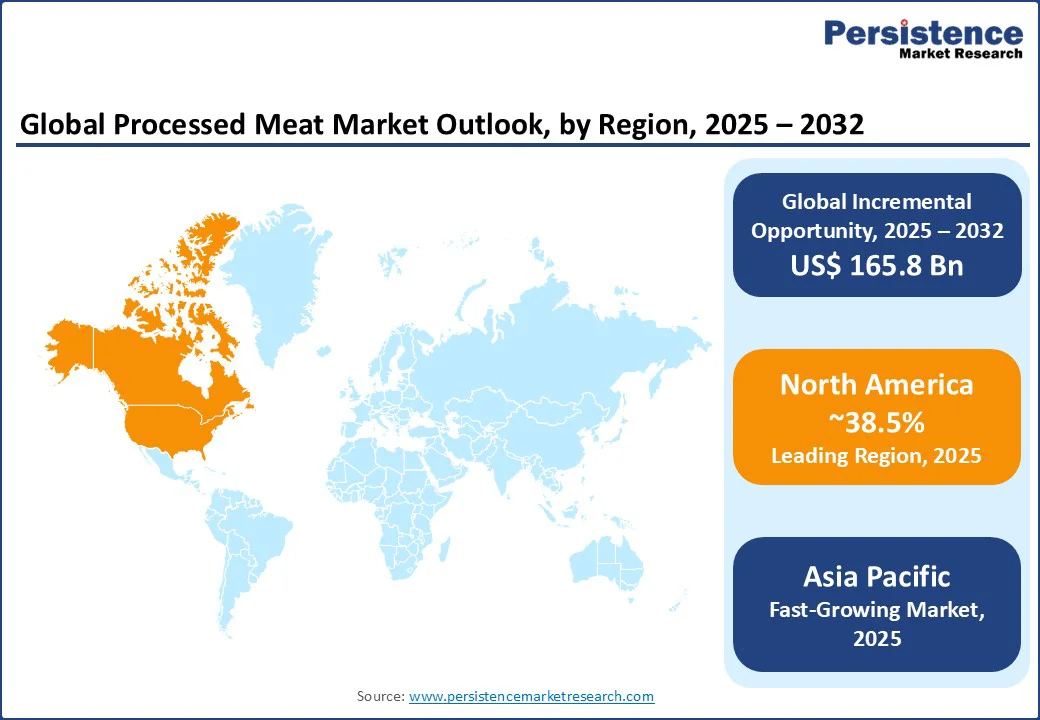ID: PMRREP10861| 188 Pages | 24 Sep 2025 | Format: PDF, Excel, PPT* | Food and Beverages

The global processed meat market size is likely to be value at US$389.2 Bn in 2025 reach US$555 Bn by 2032, growing at a CAGR of 5.2% during the forecast period from 2025 to 2032. It is experiencing robust growth, fueled by rising consumer demand for convenient, ready-to-eat food products and increasing urbanization.
Key Industry Highlights

| Key Insights | Details |
|---|---|
| Processed Meat Market Size (2025E) | US$ 389.2Bn |
| Market Value Forecast (2032F) | US$ 555Bn |
| Projected Growth (CAGR 2025 to 2032) | 5.2% |
| Historical Market Growth (CAGR 2019 to 2024) | 4.8% |
The global processed meat market is experiencing significant growth due to the increasing demand for convenient, ready-to-eat food products. Urbanization, busy lifestyles, and the growing prevalence of dual-income households have heightened the need for quick meal solutions.
Processed meats, such as hamburgers, fried sausages, and chicken nuggets, cater to this demand due to their ease of preparation and long shelf life. According to the Food and Agriculture Organization (FAO), global meat consumption is projected to increase by 14% by 2030, with processed meats accounting for a significant share.
In the U.S., the National Restaurant Association reported that 60% of consumers prefer quick-service restaurants for convenience, driving demand for processed meat products. In emerging economies such as India and China, the expansion of retail chains and e-commerce platforms, such as Amazon Fresh, further boosts accessibility.
Companies such as Tyson Foods and JBS S.A. have reported increased sales of pre-packaged processed meats in 2024, underscoring the sustained demand for convenience-driven products through 2032.
The processed meat market faces challenges due to growing health concerns and stringent regulatory standards. Processed meats, often high in sodium, preservatives, and saturated fats, are linked to health risks such as cardiovascular diseases and cancer, as highlighted by the World Health Organization. This has led to declining consumer confidence in some markets, particularly in developed regions such as Europe.
Additionally, regulatory bodies, such as the European Food Safety Authority, impose strict guidelines on additives and labeling, increasing compliance costs for manufacturers. In 2023, raw material price volatility, particularly for pork and beef, further strained profit margins, with beef prices rising by 8% globally, per the FAO.
The rise of plant-based meat alternatives, such as those offered by Beyond Meat, also poses competitive pressure, particularly in health-conscious markets, limiting growth potential for traditional processed meat products.
The rising consumer interest in sustainable and healthier food options presents significant opportunities. The growing popularity of plant-based and hybrid meat products, which combine traditional meat with plant-based ingredients, aligns with sustainability trends and health-conscious diets. The Plant Based Foods Association reported that plant-based meat sales in the U.S. grew by 45% from 2020 to 2023, indicating strong consumer interest.
Companies such as Tyson Foods and Maple Leaf Foods are investing in hybrid products, blending pork or chicken with plant-based proteins to appeal to flexitarian consumers.
Additionally, advancements in food processing technologies enable the development of low-sodium and preservative-free processed meats, addressing health concerns. Government initiatives, such as the EU’s Farm to Fork Strategy, promote sustainable food systems, encouraging manufacturers to innovate with eco-friendly packaging and cleaner labels, creating growth opportunities through 2032.

North America dominates in 2025, capturing 38.5% share, propelled by high consumption levels in both the U.S. and Canada. The strong fast-food culture in the U.S., centered on quick-service restaurants, heavily relies on staples such as hamburgers and chicken nuggets, driving significant demand.
Canada’s increasing appetite for chilled and frozen processed meat products, as highlighted by the Canadian Meat Council, further fuels regional growth. Leading companies such as Tyson Foods and Hormel Foods dominate the processed meat market, leveraging extensive distribution networks that effectively serve both retail outlets and the foodservice industry.
Additionally, consumer preferences are shifting toward convenient, high-protein meal options, reinforcing processed meat’s popularity. These combined factors position North America for continued expansion and a strong market presence through 2032.
Asia Pacific is the fastest-growing region. This growth is driven by rapid urbanization, increasing disposable incomes, and evolving dietary habits, especially in populous countries such as China and India. China, as the world’s largest pork consumer, significantly fuels demand for processed pork products. Major players such as WH Group have reported substantial sales increases in 2024, reflecting strong market momentum.
Meanwhile, India’s burgeoning fast-food industry, with popular chains such as KFC expanding rapidly, is boosting demand for chicken nuggets, hamburgers, and other processed meat items. The region benefits from expanding retail infrastructure and robust e-commerce platforms such as Alibaba, which enhance product accessibility and convenience for consumers. Additionally, government efforts to improve food safety standards and investments in cold chain logistics further reinforce market expansion.
Europe is the second fastest-growing processed meat market, fueled by robust demand in key countries such as Germany, France, and the UK. The region’s growth is supported by stringent food safety regulations that ensure high product quality, bolstering consumer confidence.
There is an increasing preference for premium processed meats, with chilled sausages and hamburgers dominating retail shelves and foodservice menus asuch as. Germany’s meat processing sector, led by industry giants such as Danish Crown, exemplifies the region’s commitment to quality and tradition.
Furthermore, the European Union’s strong emphasis on sustainable food systems, particularly through initiatives such as the Farm to Fork Strategy, is driving innovation in healthier, low-sodium options and environmentally friendly packaging. These efforts align with growing consumer demand for products that are both nutritious and sustainable.

The global processed meat market is highly competitive and fragmented, with numerous global and regional players vying for market share. Leading companies, such as Tyson Foods Inc., JBS S.A., and WH Group, dominate through extensive product portfolios, advanced processing technologies, and global distribution networks.
Regional players, such as Nippon Meat Packers in Asia Pacific, focus on localized offerings. Companies are investing in sustainable packaging and healthier product formulations to align with consumer trends, enhancing their market position through 2032.
The processed meat market is projected to reach US$389.2 Bn in 2025.
Rising demand for convenient, ready-to-eat food products and expanding quick-service restaurant chains are key market drivers.
The processed meat market is poised to witness a CAGR of 5.2% from 2025 to 2032.
The rising demand for plant-based and hybrid processed meat products is the key market opportunity.
Tyson Foods Inc., JBS S.A., WH Group, and Hormel Foods Corporation are key market players.
| Report Attribute | Details |
|---|---|
| Historical Data/Actuals | 2019 - 2024 |
| Forecast Period | 2025 - 2032 |
| Market Analysis | Value: US$ Bn/Mn, Volume: As Applicable |
| Geographical Coverage |
|
| Segmental Coverage |
|
| Competitive Analysis |
|
| Report Highlights |
|
By Product Type
By Packaging
By Meat Type
By Region
Delivery Timelines
For more information on this report and its delivery timelines please get in touch with our sales team.
About Author